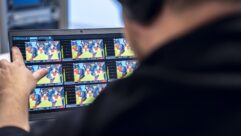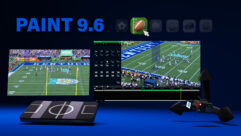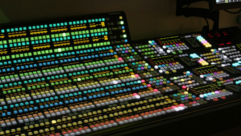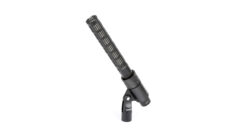
Broadcast Bar
Aug 19, 2013 3:13 PM,
By Cynthia Wisehart
Live sound meets live streaming at Fenix

Technically speaking, the first thing you notice about Fenix is the control room. Perched above the stage and reaching into the 25ft. ceilings, it’s a small, acoustically isolated space that is a broadcast booth, a recording studio, and probably one of the quietest nightclub offices in the world.
The control room says a lot about what owner Laura van Galen intended Fenix to be. She wanted her online patrons to be just as important as her inhouse guests. And she wanted the artists to be supported with quality infrastructure for both their live and virtual audiences.
For the San-Francisco area club, streaming was not an afterthought; it was a core part of the Fenix business and musical plan from the moment van Galen envisioned it five years ago. The systems had to be built as production-level infrastructure and carefully integrated with the front of house so that multiple people, including guest engineers, could work together; alternatively a single operator can control the house mix, recording, cameras, and the streamed audio and video. Merl Saunders Jr., executive director of the Fenix Entertainment Group, headed the build and technical design with a viewpoint honed in production and in the Grateful Dead family. During the two-year design/build, a unique system evolved that didn’t follow the usual playbook and which prioritized acoustics equally to electronics.
Both Saunders and acoustic designer John Storyk think they got the room right. Grammy-wining record producer and recording engineer Leslie Ann Jones agrees. “I have never heard a small room sound so good—very intimate and hardly anything coming off the stage. I could mix at a good listening level, and I know the audience felt they were in someone’s living room.” That quality, Saunders says, set the recording part of the business up for success. “I didn’t quite realize how important the quality of the room was going to be to the online experience until we were done. It really is pristine and out of that we got a great room for recording.”
It was an unlikely space. A former clothing store, it’s high asymmetrical ceilings had to stay, and Saunders and Storyk agree that was ultimately a good thing. “Laura liked the oddball geometry,” Storyk says, “and the room had great bones. The more we studied the ceiling, we saw a nice scattering and we just used a little treatment to control the low frequencies.”
The acoustics exploration started early on. Charles Salter took the first pass for permits, establishing the lay of the land and some of its quirks. Then Saunders’ pal John Meyer rang in, and evaluated the space for a Constellation system—out of reach of the budget as it happens, but Saunders says the process and Meyer’s assessment and detailed technical information was “invaluable.”
When a local Bay-area consultant was unavailable, Saunders called the opposite coast—Walters-Storyk Design Group (WSDG) in New York. John Storyk was flying out for a kid’s soccer game in Larkspur, Calif., and planning a detour to Point Reyes for oysters. Fenix—in San Rafael—was on the way.
“There were a lot of challenges on this project,” Storyk remembers. “They’re not the first club to want to record performances. But in this case it was truly an imperative, and really core to Laura’s overarching vision. To the front-of-house engineer, it’s a jazz club; to the streaming engineer, it’s a webcasting project; to the chef, it’s a restaurant; to the video guy, it’s a television station. It depends on what side of the board you’re on and what side of the business plan you’re on. This was not my first rodeo, so to speak. But the more I realized what was going on there, the more exciting it got. It had to be a lot of things to a lot of people. You sometimes risk the possibility of being mediocre for all of them. That was not the outcome anyone wanted.
“For me, the first thing is we had to get the room to sound good. If that doesn’t work, everything doesn’t work. It’s small and it had to work for acoustic instruments and reinforced instruments. It had to sound good for all the chairs and had to record well. Sometimes those characteristics are in conflict. Acoustic information in small clubs really wants to be bright. I think we were successful in getting a balance. So what does that mean? Adequate separation on the stage, yet you still hear the room, and you get the room in the mix.
“And we wanted people to be able to talk, because it is a supper club,” Saunders adds, “so we had to attack every reflective surface, and even the HVAC. John was very thorough.”
Broadcast Bar
Aug 19, 2013 3:13 PM,
By Cynthia Wisehart
Live sound meets live streaming at Fenix

The acoustically isolated control room/recording studio above the stage.
“If you’re going to stream you can’t remix,” Storyk continues. “I think controlling the low frequency in the space was most important. We used membrane absorbers over the stage and in other strategic locations to avoid a runaway condition. We got the mid-frequencies off the walls. We worked with the interior designers. They took over and patterned and refined the treatments. It was a truly iterative experience—fun working that way.”
To get a sweet spot environment for the audience while defusing audience/dining noise away from the performers, they dropped the ceiling over the front bar and dining sections. Over those areas, they floated twin recording studio-style ceiling clouds constructed with a combination of broadband and membrane absorption. The clouds angle upward from the front to the rear of the room, and aesthetically pleasing wall panels were added for absorption.
The intimate scale of the room was key to every decision. As a jazz club, it didn’t want to have a high stage. “It’s really just a small riser, one step, 13ft. by 16ft.,” Storyk says. “The sound reinforcement is actually under the stage. We had to angle the subs so they could fit. We used a lot of little subs in between each joist.” Saunders, Storyk, and WSDG project manager Joshua Morris communicated throughout the design process, via iPad/Skype in several cases. “John had been there a few times and after that we could pull drawings and measurements,” Saunders says, “I could take the iPad right up into a corner and take a picture, shoot it to him and he could send back a drawing.
“The next mission was to get the tech right,” Storyk says, “particularly a good mixing position for the front of house. It’s not the best position but it still works well.” “It’s a great fixed position!” Saunders laughs in response. “Five feet off center and a little off to the right. John wanted it in the dead center of the room where the customers had to step over it to get to their seats.”

Again, given the size of the room, Saunders wanted a small FOH footprint. “And candidly we needed a mixer that would be respected by visiting engineers, whether they were local or national acts.” He went with the Midas Pro2 console with Klark Teknik plug ins. He liked the sound. He also liked that he would have iPad control from the booth and could do all his home runs via Cat-6. “Our digital snakes are three Cat-6 lines for 56 inputs vs. a big multichannel snake.”
Saunders says he listened to a lot of speakers before he chose the EAW QX596 mounted off the walls. “They have adjustable spray (180 sweep), so we were really able to tune them,” he says.
Likewise, the team auditioned streaming providers before settling on Livestream. “Everyone has compression, but they had the best and most consistent stream and an accessible user interface—and great support, because we cannot go down,” Saunders says. “It’s a 1080p stream, but we wanted it to be on everything. We knew people were going to be watching on high-resolution flatscreens, but Livestream could also deliver to anything. Yes, it’s highly compressed on my phone and it’s not 100 percent realtime—it gets to the phone last—but it delivers what we wanted: A worldwide signal to every kind of device that reproduces the audio the way Laura wanted it to be. Livestream can actually handle what we do and that’s now been proven in over 150 shows.”
Which brings us back to the control room—something Saunders considers a key investment, at somewhere less than $20,000. Van Galen wanted a nightclub that was also a studio, or a studio that was also a nightclub. “It really sets us apart,” Saunders says. “The asset for our club is the content that we capture—the more quality, the more valuable the content. We looked at the streaming as a revenue stream from the beginning. The content was valuable, so we had to make a major investment to have the best infrastructure for that content. We have a dedicated space that’s properly equipped and sonically isolated. We’re not just tucking streaming gear into an office space and storing things in the cloud. When we’re dark, we can actually be a recording studio.”
Broadcast Bar
Aug 19, 2013 3:13 PM,
By Cynthia Wisehart
Live sound meets live streaming at Fenix

The Midas Pro2 mixing board and FOH position.
“We had to really make sure the control room was isolated,” Storyk says, “no feedback from stage. It’s tough to get a studio room-within-room construction in a confined space, so there were a lot of mechanics to getting that done.” The 8×10 room houses the video editing and streaming gear on one side and the Avid ProTools rig on the other. Moveable walls allow the positions to be isolated from one another for recording and post.
The control room receives continuous feeds from three fixed-position Panasonic AW-HE50S HD-SDI pan/tilt/zoom cameras, featuring programmable operator-control options, mounted on the lighting trusses as well as audio from an array of almost three dozen Shure, Electro-Voice, Sennheiser, and other mics. There’s also a camera input at FOH for a handheld. A split at the stage box sends AES analog stereo signal up to a NewTek TriCaster from the house console. (The show and recording can also be mixed from the ProTools desk in the control room.)
“The ideal show would have three operators,” Saunders, says, “a live guy at front of house mixing house and monitors, an engineer doing multi-track from the ProTools desk, and a video director who would call the show. But the system is also designed so that one person can run everything from the control room.
Saunders says they did not have big budget; they were just clear on their priorities. “We invested a lot of time, asked a lot of questions, and got a lot of help from music community veterans to figure out how to get the biggest bang for our buck,” Saunders says. “To have a great sounding room was an investment. We spent a great deal of time on it and probably 25 percent of the budget on acoustics materials. To be able to mix individual channels, and shoot three or four cameras, does put us ahead of what is typically being done, which is what Laura wanted, so that helped us figure out the gear and the system design. The control room was an investment. But we also saved thousands in cable runs at the same time—the speaker runs are less than 15ft. from the power.” Making budget, he says, was a matter of how they thought about things, and having the time to iterate.
“The recordings are truly great,” Sanders says with no small satisfaction. “The archive is virtually unedited; we typically just take out any long pauses. Because the room is so clean, all the recordings have a consistent feel, even though the personality and demographics of the room changes every night.”
This sense of place—inspired by Austin City Limits—can’t be underestimated as a part of the experience, as well as the Fenix brand, if you will. They planned the system to support big success, what Saunders calls the “Oprah moment” when people from all over the world figure out you have something special. Already global viewership is rising by 20 percent weekly on the FenixLive Channel at www.livestream.com/fenixlive with 520,000 minutes viewed in more than 64 countries.










